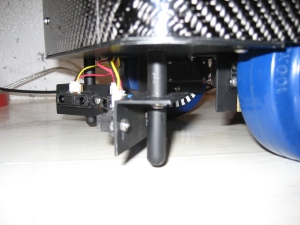Obstacle detection using OpenCV
December 18, 2014 4 Comments
I have been working on a way to detect obstacles on the floor in front of the robot using the webcam and OpenCV. I have had some success and I have made a short video of the obstacle detection in action.
The method I am using involves capturing an image, converting it to grayscale, blurring it slightly and then using canny edge detection to highlight the edges in the image. Using the edge detected image, starting from the left and moving along the width of the image in intervals, I scan from the bottom of the image until I reach a pixel that is white, indicating the first edge encountered. I am left with an array that contains coordinates of the first edges found in front of the robot. Using this array, I then look for changes in the direction of the slope of the edges that may indicate an object is present. At the moment I am ignoring anything in the top half of the image as anything found here will probably be far enough away from the robot to not be too concerned about. This will change depending on the angle of the head. If the head is looking down towards the ground, obviously everything in the scene may be of interest. With the changes of slope found, I then scan in both directions to try and find the edge of the object, indicated by a sharp change in values in the array of nearest edges.
This method seems to work quite well but some tweaking may be required for it to work in all environments. I am planning on using the coordinates of the edges of the obstacles found to create a map of some kind of the area in front of the robot. Combined with the coordinates of the target the robot is heading for, I hope to be able to plan a path for the robot to follow to reach the target.
For anyone that is interested I have put my code on Github. It is a work in progress but may be worth a look!
